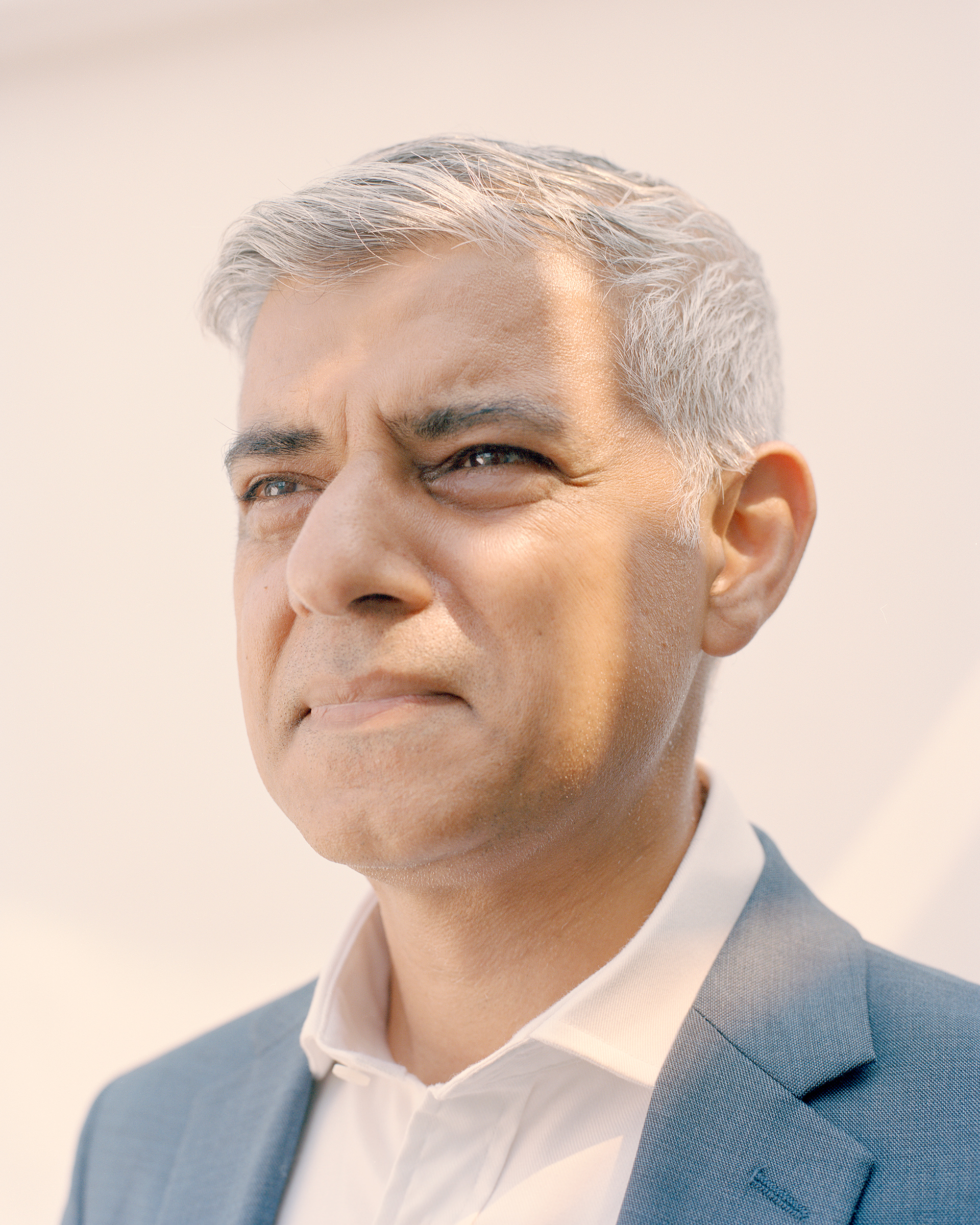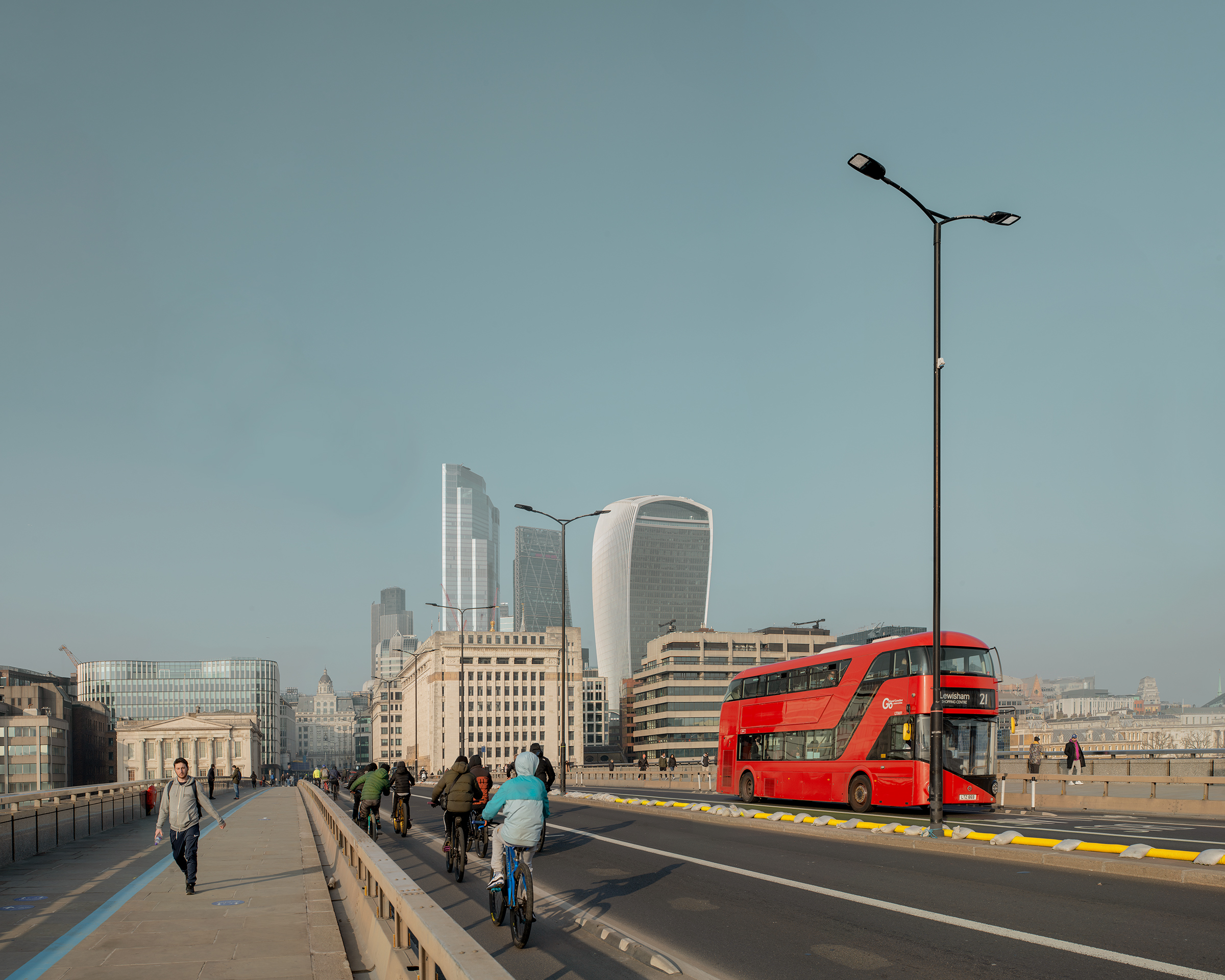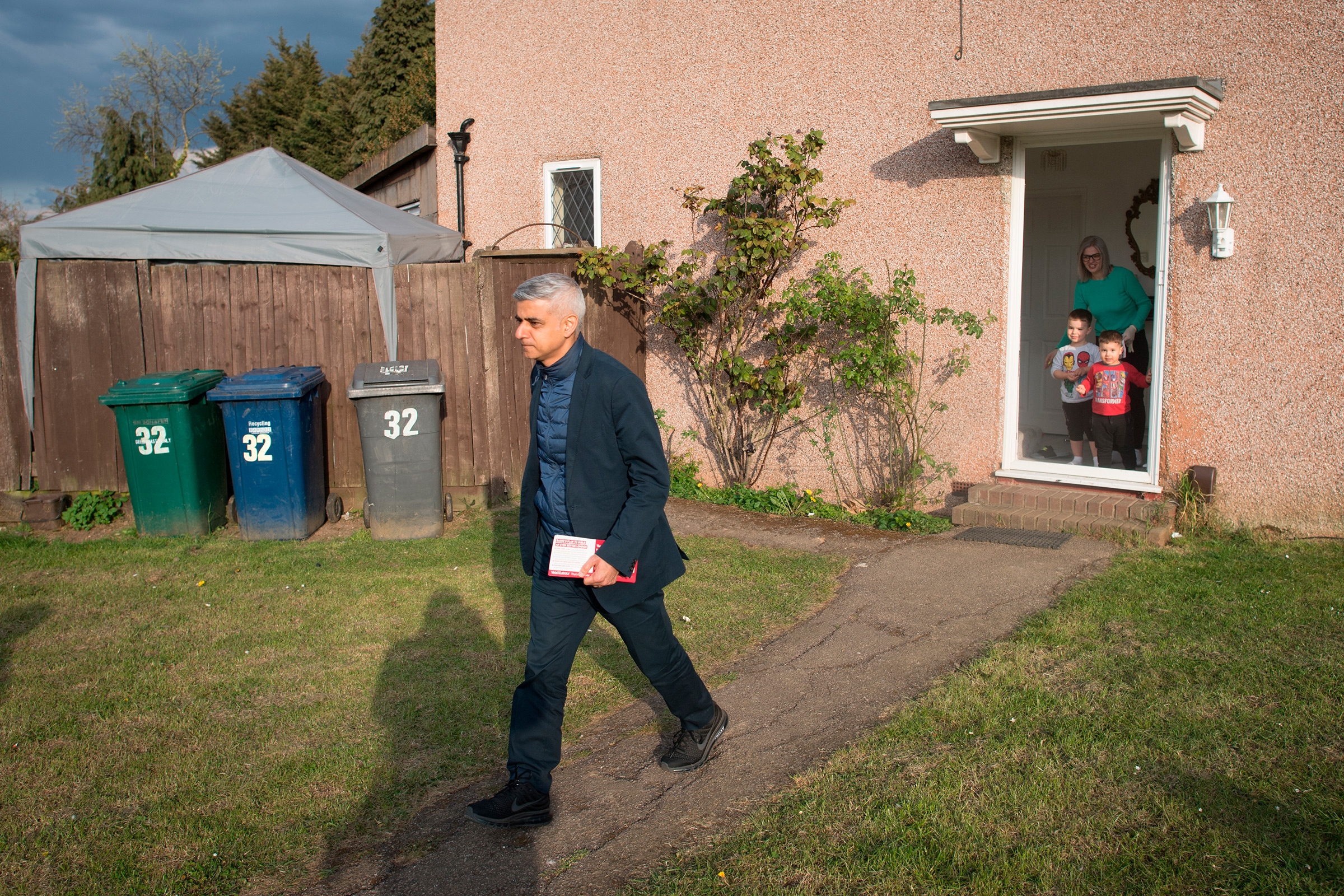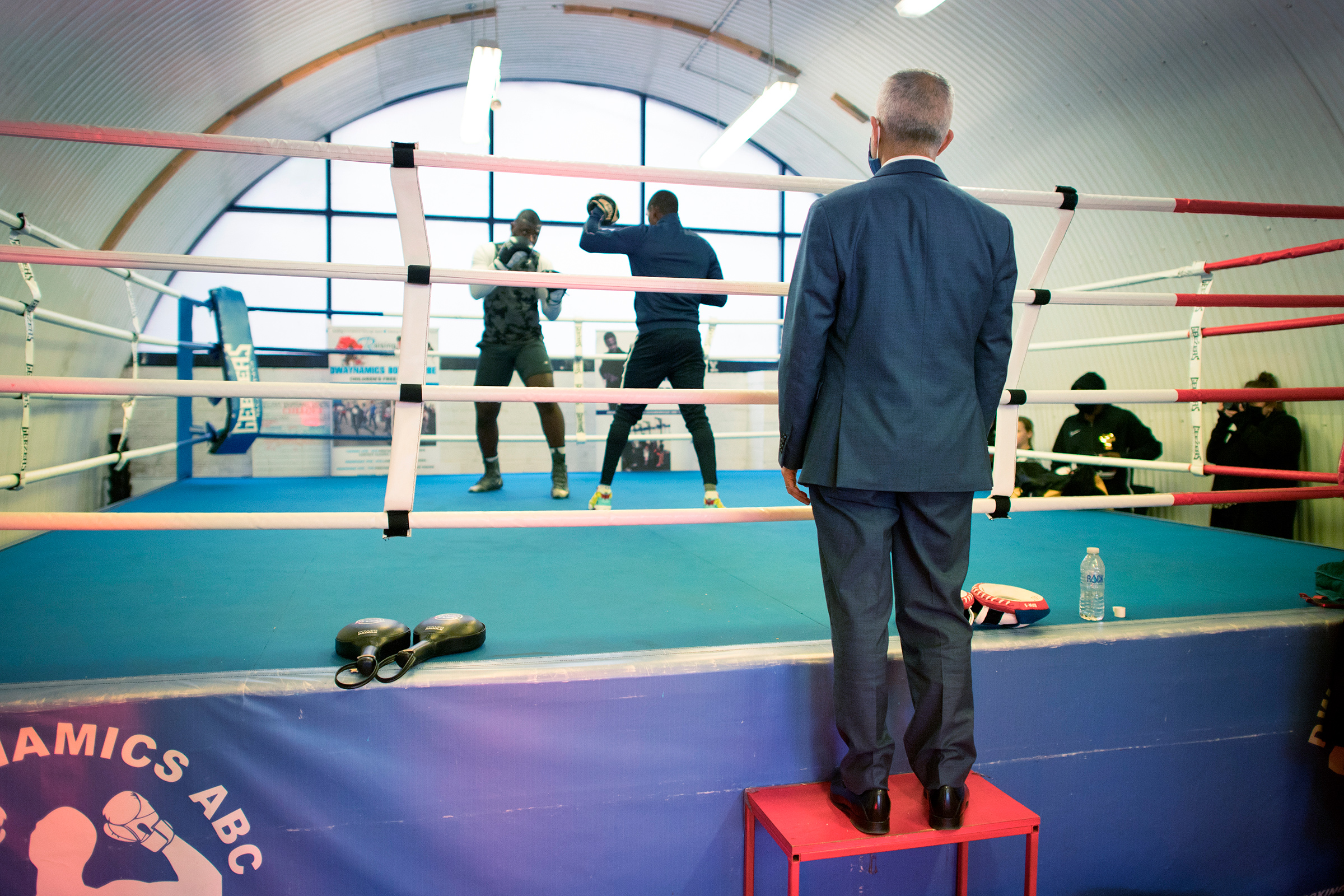
There’s a spot of mud on Sadiq Khan’s white shirt. The London mayor has arrived late after a tree-planting ceremony and he hasn’t had time to clean it, he apologizes, as he strides into a cavernous meeting room at city hall. It’s late June, but thick gray clouds hang low in the sky over Tower Bridge and the panoramic view of the city from the bulbous glass building’s balcony. “The running joke is that I like to sit out on a deck chair and enjoy the weather,” he says.
He doesn’t have much time for that. Khan won a second term as mayor in May, just as the city began reopening in earnest after almost five months of lockdown. Like the rest of the world’s large cities, London is reeling from the past 18 months, which have both exacted a heavier immediate toll on urban areas and thrown the chronic problems of big-city life into harsh relief.
With crowded housing and pockets of extreme deprivation alongside its more affluent neighborhoods, London has suffered the U.K.’s highest per capita death rate from COVID-19, with more than 15,000 lives lost. Black and Asian people, who make up at least 31.8% of Londoners, were up to four times as likely as white people to die from the virus nationwide. Those communities joined worldwide protests over racial injustice over the past year, forcing London to interrogate its policing policies as well as disparities in employment and housing. The number of Londoners in paid jobs fell by 5.5% from February to December 2020—by far the largest drop of any U.K. region, with low-income workers hit hardest. Meanwhile, wealthier residents have abandoned the city as remote working became the norm and lockdowns made cramped apartments unattractive. London’s population is projected to fall by an estimated 300,000 this year, which would be the first decline in three decades. The exodus is exacerbated by the U.K.’s departure from the E.U. in January 2020, which has made it harder for Europeans to live and work in the city and undermined its status as a global financial hub.
To cap it all, in the summer of 2021, like cities in the U.S., China and Germany, London got a taste of an even greater forthcoming crisis, as unusually heavy rains twice cut power, closed transport links and inundated homes in parts of the city.

Londoners have backed Khan to get them through it. A former human-rights lawyer, raised by a Pakistani bus driver and a seamstress in housing projects in South London, Khan was first elected in May 2016 and widely celebrated as a symbol for the city’s progressive values and demographic diversity. He burnished that image through a long-running feud with President Donald Trump, famously allowing activists to fly a giant balloon depicting the U.S. President as a baby over the U.K. Parliament building during his visit in 2018. Though his leftist Labour Party has trailed the ruling Conservatives by a double-digit margin for most of 2021, Khan ties with Manchester mayor Andy Burnham as the party’s most popular active politician, according to pollster Yougov. In May’s election (which was delayed by a year owing to the COVID-19 pandemic) Khan won the second greatest number of votes at a mayoral election of any candidate in the two-decade history of the office, after his own win in 2016. He is still daily hounded for selfies by young Londoners.
Sitting with a view over the city skyline, Khan is clearly feeling ebullient, despite the crises facing London. A lifelong boxing fan, he compares them to the 1974 “rumble in the jungle” between George Foreman and Muhammad Ali. “Foreman thought he had Ali for seven rounds. Then Ali used the ropes and came back and knocked Foreman out,” he says.
He speaks at characteristic breakneck speed, reeling off a plan to use the COVID-19 recovery to build a “greener, fairer London”: combining efforts to create jobs for struggling Londoners and improve deprived areas with the climate action needed to meet his 2030 net-zero emissions goal for the capital. “We know how to bounce back from things. So for anybody who thinks they’ve got us on the ropes, the history of London is Muhammad Ali, knocking people out.”
It’s hard not to compare Khan with his immediate predecessor as London mayor: the U.K.’s now Prime Minister Boris Johnson. During his two terms, Johnson—educated at the elite boarding school Eton and Oxford University—developed a reputation as a gaffe-prone and out-of-touch but undeniably charismatic celebrity mayor. He balanced his duties with writing a well-paid weekly newspaper column, poured nearly $60 million of public money into a doomed project to build a “garden bridge over the Thames,” and once got stuck on a zip wire over London during the 2012 Olympic Games.
Khan cuts a very different figure. In person, he’s relaxed and friendly but lacks the flamboyance and comic bravado that allowed Johnson to get away with straying from his brief. Khan retains a lawyerly focus on evidence, firing off reams of facts to justify his policies, which so far have eschewed grand infrastructure projects. He is also a notoriously hard worker, says Ross Lydall, who has covered city hall for two decades for the London newspaper Evening Standard. “Boris didn’t really see it as a five-day-a-week job. Sadiq sees this as a seven-day-a-week job.”
Ed Miliband, a fellow Labour lawmaker who led the party from 2010 to 2015, describes Khan as “unflashy” and “incredibly principled.” He cites an episode in the wake of London’s deadly 2005 terrorist bombings when the Labour government attempted to pass a law to allow police to hold terrorist suspects for 90 days without charge. Khan resisted stiff party pressure and threats against his career to vote against it. “I think it does say something about Sadiq,” Miliband says. “There’s a sort of seriousness, a decency, a set of values in him which is really unusual.”
It could be argued that the job of London mayor is actually suited to an exuberant booster like Johnson rather than a cautious and quietly determined figure like Khan. The mayor has fairly limited powers, beyond acting as a spokesperson for London internationally, and negotiating on the capital’s behalf for prioritization from the central government. The office controls less than 7% of taxes raised in the city, compared with roughly 50% for its New York counterpart. The mayor has some influence over policing and control of some funds to build new housing, but their powers lie mostly in authority over London’s transport and road policy.
Within those strictures, Khan has channeled much of his energy into cleaning up London’s highly polluted air, through a bold crusade to reduce car traffic and improve vehicle standards. Air quality is a personal issue for Khan, who was diagnosed with adult-onset asthma while training for the London Marathon in 2014 and so has to use an inhaler “religiously twice a day.” But it’s also a matter of racial and social justice, he says. “Who do we think it is that has stunted lungs, or the cancer, or the heart disease, or the lung diseases? It’s poorer Londoners, least likely to own a car living in deprived communities. And you can see it in the life expectancy of Black, Asian and minority ethnic Londoners vs. others. Those gaps will narrow as a result of my policies.”
But let’s have an arms race: Who can be the most green leader?
His flagship policy so far is an ultra-low-emissions zone (ULEZ) introduced in April 2019, which requires Londoners with more polluting cars—mostly petrol cars made before 2005 and diesel cars made before 2015—to pay a roughly $17 charge when they enter the city center. That’s on top of $21 for the daily congestion charge, which was first introduced in 2003. The ULEZ has helped reduce the number of people living in areas with illegal levels of nitrogen dioxide by 94% since the start of his term, according to city hall.
Air quality has served as a kind of Trojan horse for Khan to push action on the climate crisis, says Mark Watts, director of the C40 coalition of 97 climate-leader cities. “Sadiq’s skill is that he’s really good at bringing the policies that are being implemented to deliver emission reductions closer to what most people’s everyday concerns are: their [health] and jobs,” Watts says. As the ULEZ pushed people to switch to newer hybrid vehicles or to abandon cars altogether, by the end of 2019 it had caused a 6% drop in central London’s road-related carbon emissions compared with a scenario without the strategy. The impact is expected to grow in the coming years, particularly after the zone expands in October to cover an area 18 times as large as its original size. “The ULEZ is, no question, one of the strongest climate policies in the world for transport in any city in the world,” Watts says.
Alongside the ULEZ, Khan expanded protected cycle lanes fivefold in his first term to cover 162 miles and bought hundreds of electric buses and dozens of hydrogen ones. From 2017 to 2021, he phased out all of the most polluting pure diesel-fuel buses in London’s 9,000 strong fleet, and by 2037, the goal is for all London buses to be zero emissions. Watts says Khan has also pioneered policies that have then been taken up by other cities, such as a scheme for city pension funds to divest from fossil fuels (joined by 13 other cities) and a plan to ban fossil cars from large parts of town by 2035 (joined by 35).
Not everyone in London has welcomed these policies. The planned expansion of the ULEZ is proving controversial. John Moss, a local councillor in the northeastern district of Waltham Forest, part of which will fall in the new ULEZ zone, says the evidence produced by the mayor for the expansion shows little benefit for London’s air quality by 2030 compared with that produced by the original zone.
He says the $17 daily charge will be a brutal hit for those low-income workers like cleaners and nurses who live in outer regions of the city and rely on their cars to travel to shifts at hours when public transit is not always available. “There’s a district nurse who lives [100 yards north of the ULEZ boundary] who has contacted me seven times saying, ‘What can I do?’ She’s got a four-year lease on a car. What’s she supposed to do with that?”
The mayor has offered $78 million in small grants of a few thousand dollars to help Londoners pay to replace their vehicles, including pots specifically for low-income and disabled people and work vans. But high demand is expected to burn through those funds by the end of summer, with just $17 million remaining at the end of June, according to the Evening Standard.
The mayor also faces criticism from environmental activists over a planned new road tunnel under the river Thames. Campaigners say the project will lock fossil-fuel infrastructure into the city, encouraging more people to drive and undermining the 2030 net-zero target.
Khan is pressing ahead, though. His office says that the tunnel is needed to reduce reliance on a Victorian-era tunnel that has proved vulnerable to flooding, and that modeling suggests it will not increase overall traffic numbers in the city because it will be tolled. “As a former lawyer, I base my policies in evidence plus my values,” Khan says. “[Opposition] will happen along the way. And so you’ve got to be ready for that, with the evidence to try and persuade people: that actually what we’re doing we think is really important. It’s what leadership is about.”

Khan has also announced a series of funding pots designed to stimulate the sectors that need to grow as London decarbonizes—a $14 million green new deal package for projects that create jobs in green tech, electric-vehicle infrastructure and solar-panel installation; $5 million for projects that make it easier for social-housing providers to retrofit their buildings; $156 million for public-sector buildings to improve their energy efficiency. He says his green recovery plan aims to avoid what he saw coming of age amid a period of mass unemployment in the 1980s. “Many of my mates were written off. If you lived in a poor area, didn’t have skills, didn’t have contacts, you couldn’t get a job,” he says. “My plan is to make London a global beacon of green investment and jobs, and train Londoners up to do them.”
Yet most of these funds are relatively modest, and will directly fund only a few thousand jobs. Khan claims they will encourage private investment, supporting more than 170,000 posts in retrofitting, electric charging and other fields. But without the full weight of the taxpayers’ purse behind him, the success or failure of Khan’s 2030 net-zero goal for London will depend greatly on the national government.
In recent months Johnson has, like Khan, been vying for recognition as a climate leader, using the U.K.’s hosting of COP26 in Glasgow in November as a platform and setting an ambitious target to reduce the U.K.’s greenhouse-gas emissions by 78% by 2035 compared with 1990 levels. Critics say his plan is light on details. Khan says he hopes the Prime Minister comes through with them, despite doubts about his predecessor’s track record on the environment in London. “As far as I’m concerned, I’m the first green mayor London has ever had. But let’s have an arms race: Who can be the most green leader?”
In May, Khan visited a bus factory in North Yorkshire. The factory, which has provided dozens of electric buses to London’s transport agency, is an example, the mayor says, of how the capital’s need for new infrastructure as it decarbonizes can drive industry in the rest of the country. He’s made several such trips over his time in office, and also placed op-eds in regional newspapers. The aim, he says, is to “counter the animus, the us-vs.them feeling” that many in the U.K. have toward the country’s capital and financial hub, and an anti-London sentiment inside the national government, which is pouring billions of pounds into a plan to “level up” other regions to match the capital’s financial power.
It could also be read as laying a foundation for national office. Khan has often ranked among the favorites to be the next leader of the Labour Party. His 2016 victory was the first Labour win in a major election since 2005, leading some to see him as a ray of hope for a social democratic center-left that has foundered across the U.K. and Europe over the past decade, after dominating politics for much of the late 20th century. Just six of the E.U.’s 27 states—Portugal, Denmark, Sweden, Finland, Malta and Spain—have center-left governments. In France, the establishment Socialist Party was eclipsed by Emmanuel Macron’s centrist movement in 2017 and has polled in the single digits ever since. In Germany, the Social Democratic Party has lost ground to the Greens and trails third behind them and the center-right in voting intention for the September elections for Chancellor.

In the U.K., Labour has struggled with an identity crisis after Brexit, which Labour opposed, and a tumultuous five years under far-left former leader Jeremy Corbyn. The party has suffered bruising defeats in the country’s past four general elections, culminating in the 2019 loss of 59 seats, the second worst performance by any opposition for a century. In May the party lost a special election for Parliament in Hartlepool, a seat in the north of England held by Labour since its creation, shaking confidence in new leader Keir Starmer, whom the party backed in 2020 to stem the damage.
Khan has repeatedly insisted he doesn’t view the mayoral role as a stepping-stone. When asked if he would lead the Labour Party one day, he dodges the question: “I think the Labour Party is going through a difficult time nationally,” he says. “I’ve got confidence in Keir as someone who is going to bring us back to being competitive. At the moment we’re not competitive.”
Khan says the route back to national power lies in taking seriously the root causes that have driven people away from the left. “Whether it’s Trump, or the President of Brazil, or the President of Poland, their voters are actually decent people. But there’s something about the lives they lead, where they think the progressive movement can’t address their concerns. We can’t write them off. We’ve got to actually listen to them, engage with them and provide leadership.”
It’s not a groundbreaking formula, and putting those insights into practice on a national level may take Labour years. But for now, with the wind in his sails in London, Khan is happy to revel in his ability to outlast one right-wing figure. He offers what could be a final salvo in his feud with the former U.S. President. “I think one of Trump’s tweets in reference to me was ‘stone cold loser,’” he says, raising his eyebrows. “Well, I won my election.”
More Must-Reads from TIME
- How Donald Trump Won
- The Best Inventions of 2024
- Why Sleep Is the Key to Living Longer
- Robert Zemeckis Just Wants to Move You
- How to Break 8 Toxic Communication Habits
- Nicola Coughlan Bet on Herself—And Won
- Why Vinegar Is So Good for You
- Meet TIME's Newest Class of Next Generation Leaders
Write to Ciara Nugent at ciara.nugent@time.com